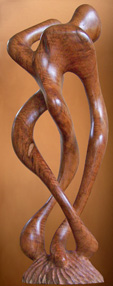CARPAL TUNNEL SYNDROME
PREVENTION AND CURE
It has been accepted from anecdotal evidence that carpal tunnel syndrome is an overuse syndrome. This myth is challenged with vast contradictory observations, but the overuse explanation has led to a multi-billion dollar industry. My experience over the past thirty years has been that carpal tunnel is almost always the result of under training, not overuse.
In cases where carpal tunnel syndrome can be traced to overuse it was precipitated by tenosynovitis that resulted from sudden extreme overuse.The difference is important because from the under-use perspective self-treatment is not only possible but preferable and in my experience almost universally successful
THE SELF-TREATMENT takes about 15 minutes a day. I recommend persisting for 6 weeks to prevent recurrence. The challenge of the exercise is getting them done. I suggest scheduling fifteen minutes paired with something you do every day
The regime is a simple sequence of consisting of 1 minute warm up, 2 minutes of stretching, 10 minutes of conditioning with weights, 2 more minutes of stretching, and 1 minute cool down. For each hand you will need 3 dumbbells: one pound, two pound, and three pound. There are five sections of exercise.It is important that these be exercises be done in sequence and together!
I) WARM UP
II) STRETCH
III) WEIGHTS
IV) STRETCH
V) COOL DOWN
I WARM UP/ COOL DOWN
Warm up consists simply of moving the hands back and forth for 60 seconds.
Stretching is done in two steps in each case the elbow is straight but not locked. First press palm against a flat surface and press to the point of feeling some stretch WITHOUT ANY PAIN for sixty seconds;Second, turn the hand over and press for 60 seconds stretching WITHOUT ANY PAIN. The intent of the stretch is to maintain range of motion not to increase it.
II STRETCH
.
Sometimes holding either of these positions cause tingling, numbness or pain before the minute is up. In this case hold the position for a shorter period and turn the hand over and stretch in the other direction for the same period of time until a minute is reached for both sides. If this type of discomfort is present, it should disappear within 3 weeks.
III WEIGHT EXERCISES
Begin with one pound weight. If your wrist fatigues or numbness is too much, you can begin without weight or withless than one pound. At any time a weight seems too heavy, drop it, and complete the round’s repetitions without weight.
There are four hand positions. In each position the hand is rotated 90 degrees from the previous positions. In each position the weight is lifted from the ground toward the sky. In each position the movement is done 30 times. After all four positions have been completed the sequence is repeated three times. Please note that at one pound this is 360 pounds of lifting.
A. The thumb side of the hand is up.
B. The knuckles are facing up.
C. The little finger side of the hand is facing up.
D. The palm is facing up.
Grip: thumb and fingers wrapping grasping from the same side.
Elbow Position: Elbow should be straight but not locked.
Shoulder: To protect the shoulder put your arm over the back of a couch or chair.
IV STRETCHING
Stretching is the same as II above.
V COOL DOWN
Cool Down is the same as I Warm Up.
NOTES
COOL DOWN AND WARM UP ARE CRITICAL.
WARNING: doing the weight exercises alone is liable to irritate the existing condition not correct it
What to expect—for the first two weeks there is likely to be some new arm soreness and the carpal-tunnel symptoms may increase or become intermittent and the forearms should be noticeably stronger.
Begin-- using only one pound. If one pound is too much, begin doing the wrist exercises without any weight. The weight work should fatigue your forearms somewhat; it should not be causing great struggles or pain.
Shoulder protection-- keep your elbow straight but not “locked” for these exercises. Rest your arm between shoulder and elbow across the back of a chair or couch to avoid putting too much stress on the shoulder muscles.
Increasing resistance-- each time you increase weight stay with that increase for at least two days before further increasing the weight. It is wise to increase resistance incrementally. For instance, after you are comfortable with one pound of weight, continue using the one pound weight for the first and last set and use the two pound weight for the middle set. If you progress slowly, success is assured. If you push too quickly you are liable to make your situation worse.
Finishing-- by the time it is comfortable to do this exercise program with three pounds all symptoms have usually ceased. I recommend staying with the regime for at least six weeks although symptoms have usually receded before then.
Other considerations—If you are engaging in particularly intense activities like rock climbing, wind surfing or sustained carpentry work, it is a good idea to build up to using five pounds. If you have damaged the myelin sheathing of the median nerve, in my experience this conditioning regime works but must maintained so surgery may be a more practical solution. These exercises can be done prophylactically.
Soreness can be decreased and progress accelerated by massage to the upper extremities but it is not necessary.
